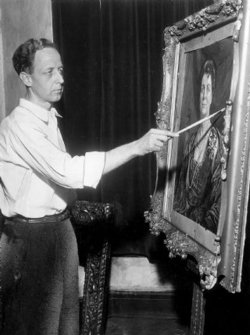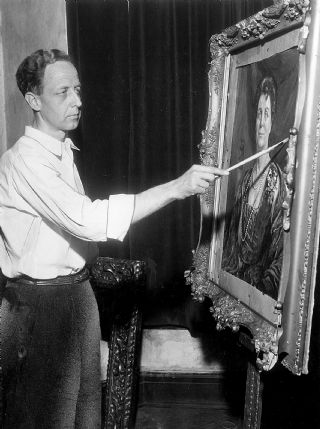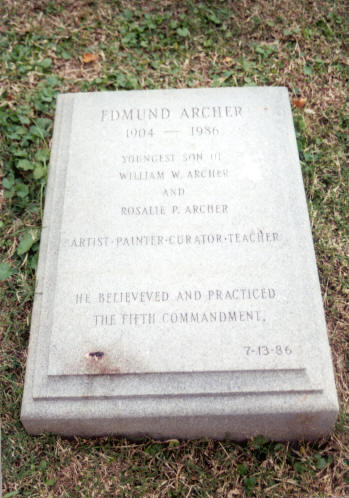American Portrait and Mural Artist. The son of a newspaper editor, he became interested in art from his early childhood and took art classes from local artists. In 1916, he traveled to Cape Cod, Massachusetts, to attend the Charles Hawthorne Art School, and two years later, he won first prize in a local bond drive poster contest. In 1919, he received an honorable mention in an exhibition of one of his paintings. In 1922, he studied for two terms at the University of Virginia at Charlottesville and then traveled to New York City, New York, to study at the Art Students League. From 1926 until 1927, he spent time in Italy, studying Renaissance artists, then in Paris, France, where he worked at the Academie Colarossiu and in a studio that he rented. He then returned to Richmond, Virginia, where he painted portraits and used African Americans as models. From 1927 and 1929, his works were included in exhibitions held by the Whitney Studio Club in New York, which included "Bathers, East River," "Man from Bordeaux," and "Cornfield Negroes." In 1930, he was named an assistant director of the new Whitney Museum of American Art in New York City. During the Chicago 1934 World's Fair, his painting, "Waiting for the Departure," was included in a comprehensive exhibition of paintings from American collections held at the Art Institute, and In 1938, the Virginia Museum of Fine Arts gave him a solo exhibition that included a mural, "Captain Francis Eppes Making Friends with the Appomattox Indians." In 1940, he left his position at the Whitney Museum and moved to Washington, DC, where he lived during World War II and served in the 603rd Engineering Battalion, a US Army unit responsible for camouflage and other visual deception that was made up largely of artists, illustrators, and designers. In 1944, he took a position as an art instructor at the Corcoran School of Art and occasionally taught at nearby George Washington University. In 1968 he retired from teaching and moved back to Richmond, where he died at the age of 81. Edmund's stateside WWII service was with the secretive unit known as the Ghost Army, whose records were not declassified and made public until 1996, ten years after his death.
American Portrait and Mural Artist. The son of a newspaper editor, he became interested in art from his early childhood and took art classes from local artists. In 1916, he traveled to Cape Cod, Massachusetts, to attend the Charles Hawthorne Art School, and two years later, he won first prize in a local bond drive poster contest. In 1919, he received an honorable mention in an exhibition of one of his paintings. In 1922, he studied for two terms at the University of Virginia at Charlottesville and then traveled to New York City, New York, to study at the Art Students League. From 1926 until 1927, he spent time in Italy, studying Renaissance artists, then in Paris, France, where he worked at the Academie Colarossiu and in a studio that he rented. He then returned to Richmond, Virginia, where he painted portraits and used African Americans as models. From 1927 and 1929, his works were included in exhibitions held by the Whitney Studio Club in New York, which included "Bathers, East River," "Man from Bordeaux," and "Cornfield Negroes." In 1930, he was named an assistant director of the new Whitney Museum of American Art in New York City. During the Chicago 1934 World's Fair, his painting, "Waiting for the Departure," was included in a comprehensive exhibition of paintings from American collections held at the Art Institute, and In 1938, the Virginia Museum of Fine Arts gave him a solo exhibition that included a mural, "Captain Francis Eppes Making Friends with the Appomattox Indians." In 1940, he left his position at the Whitney Museum and moved to Washington, DC, where he lived during World War II and served in the 603rd Engineering Battalion, a US Army unit responsible for camouflage and other visual deception that was made up largely of artists, illustrators, and designers. In 1944, he took a position as an art instructor at the Corcoran School of Art and occasionally taught at nearby George Washington University. In 1968 he retired from teaching and moved back to Richmond, where he died at the age of 81. Edmund's stateside WWII service was with the secretive unit known as the Ghost Army, whose records were not declassified and made public until 1996, ten years after his death.
Bio by: William Bjornstad
Family Members
Advertisement
See more Archer memorials in:
Explore more
Sponsored by Ancestry
Advertisement








